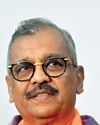
Draping the traditional red and white Assamese gamcha around his neck, Chief Minister Himanta Biswa Sarma looked content as he stepped out of the North Block on the evening of December 29. The conference room in the British-era building, where he sat with United Liberation Front of Asom (ULFA) chairman Arabinda Rajkhowa and general secretary Anup Chetia, has witnessed the resolution of many demands for sovereignty left unresolved by the British, especially in the northeast. After the meeting, Sarma, Chetia and Rajkhowa agreed to a solution to the rebellion waged by ULFA since 1979, marking the beginning of the end of one of the longest-running insurgencies since independence.
As Union Home Minister Amit Shah joined the trio to sign the tripartite agreement, it was a symbolic ‘Ek Bharat, Shreshtha Bharat’ moment. For Sarma, it was also a triumph of his love for the Brahmaputra valley, which was very much at display when they all exchanged gamchas, an article of significance worn by the indigenous people of Assam. It cemented Sarma’s position as the tallest leader from Assam.
The northeast is geographically cut off from the rest of the country, but for the narrow Siliguri Corridor, known as the Chicken’s Neck. This region shares borders with Bhutan, Bangladesh, Nepal and China, and has historically been the playground for armed insurgent groups like ULFA. Lives of the people in the northeast have been split between cries for sovereignty by armed insurgent groups and their own desire to participate in the growth story of the rest of the country.
This story is from the {{IssueName}} edition of {{MagazineName}}.
Start your 7-day Magzter GOLD free trial to access thousands of curated premium stories, and 9,000+ magazines and newspapers.
Already a subscriber ? Sign In
This story is from the {{IssueName}} edition of {{MagazineName}}.
Start your 7-day Magzter GOLD free trial to access thousands of curated premium stories, and 9,000+ magazines and newspapers.
Already a subscriber? Sign In

TAKING WINGS AGAIN
Telangana plans to redevelop Warangal's Mamnoor airport, built by the Nizam and destroyed by the Indian Air Force during Hyderabad's annexation in 1948
Identity tracking
Without reading like a tutorial, The Tamils gives a comprehensive account of the community's history and culture

THE ART OF WINNING
The real drama of the Oscar race happens before the envelope opens

Kala cotton is pure magic
One of the greatest things about being a fashion journalist in India is that you are never just one thing. Your stories can take you to glamorous fashion weeks across the world, and they can also take you to the remotest parts of India, allowing you to tell stories of people whose voices have been quietened. Like the farmers of the indigenous kala cotton plant.

Revival mode
Jitendra Patwari has set off a generational shift in Madhya Pradesh Congress

No freedom in appeasement
Fearsome gods and kings are appeased, not opposed. Through history, this ingrained placatory habit is ordained by all religions and cultures.

NIA WILL TRY RANA FOR CHARGES THAT HAVE NOT BEEN DISCLOSED
A high-profile lawyer, Ujjwal Nikam has argued crucial cases for the government. He was special public prosecutor in the 1993 Mumbai bomb blasts case and the 26/11 attacks case. His arguments led to the conviction of terrorist Ajmal Kasab, who was executed in 2012.

Men, too, have glass ceilings
The more I read about rape, suicide, family troubles, unemployment, toxic masculinity, excessive religiosity and hysterical jingoism, the more I feel we have got hold of the wrong end of the stick.

Jumbo love
Laxmi, once forced to beg on Mumbai streets, found home and freedom at the Wildlife SOS - Elephant Conservation and Care Centre in Mathura

THE DEVIL AND THE DETAILS
The extradition of Tahawwur Rana, whom US President Donald Trump called a \"very violent man\", could tie loose ends related to 26/11 and lead to the uncovering of valuable intelligence on attacks planned on India thereafter